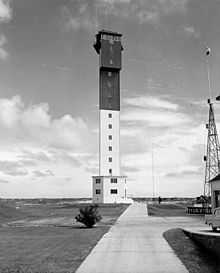Charleston Light
 | |
| Charleston Light on Sullivan's Island | |
 Charleston Light | |
| Location | Sullivan's Island, South Carolina |
|---|---|
| Coordinates | 32°45′28.5″N 79°50′35.7″W / 32.757917°N 79.843250°WCoordinates: 32°45′28.5″N 79°50′35.7″W / 32.757917°N 79.843250°W |
| Year first constructed | 1960 |
| Year first lit | 1962 |
| Automated | 1975 |
| Foundation | Concrete |
| Construction | Steel with aluminum alloy skin |
| Tower shape | Triangular |
| Markings / pattern | Upper half black, lower half white |
| Height | 140 ft |
| Focal height | 163 ft |
| Original lens | DCB 24 |
| Current lens | DCB 24 |
| Range | 26 nm |
| Characteristic | Flashing white, 2 every 30 sec. |
| Fog signal | none |
| Admiralty number | J2646 |
| ARLHS number | USA-825 |
| USCG number | 3-195 |
Charleston Light on Sullivan's Island, South Carolina, which is the northern entrance to Charleston Harbor, was built to replace the defunct Morris Island Light on Morris Island. Construction was started in 1960, and it was first lit on June 15, 1962.
The lighthouse has a steel frame, an aluminum alloy skin, and a triangular cross section. It is 140 ft (42.7 m) tall. The focal plane of the light is 163 ft (49.7 m) above mean sea level. Originally painted white and red-orange, it is now a black upper half and white lower half. It is the only U.S. lighthouse with an elevator and air conditioning and was the last on shore manned lighthouse to be built. Only the Texas Tower Offshore Lighthouses were built later starting in 1961 with Buzzards Bay Entrance Light.
It has a DCB 24 light. It originally had 28 million candelas (candlepower) and was the second most powerful in the Western Hemisphere. As the light was actually too dazzling, the power was lowered to 1.2 million candelas and could still be seen over 26 miles.[4] Its characteristic is two 0.2 s flashes separated by 4.8 s every 30 s.[2] The light was automated in 1975.[1]
| Wikimedia Commons has media related to Charleston Light. |
Images
 Charleston Light on Sullivan's Island. |
 Charleston Light viewed from the beach at dusk. |
 Charleston Light viewed from the beach at night. |
References
- ↑ 1.0 1.1 "Historic Light Station Information and Photography: South Carolina". United States Coast Guard Historian's Office.
- ↑ 2.0 2.1 Light List, Volume III, Atlantic Coast, Little River, South Carolina to Econfina River, Florida (PDF). Light List. United States Coast Guard. 2012. p. 2.
- ↑ Rowlett, Russ. "Lighthouses of the United States: South Carolina". The Lighthouse Directory. University of North Carolina at Chapel Hill.
- ↑ http://www.lighthousefriends.com/light.asp?ID=334
External links
- Lighthousefriends - Charleston Light page
- NPS Inventory of Historic Light Stations - Charleston Light